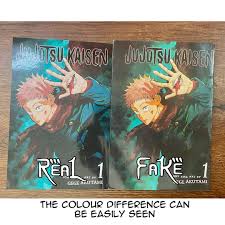
How to Spot Authentic Manga Editions and Avoid Fakes
Share
How to Spot Authentic Manga Editions and Avoid Fakes [Updated Guide]
Collecting authentic manga editions isn't just about owning a piece of your favourite series—it's about protecting your investment and supporting the artists behind the stories. Fake manga editions can flood the market with poor-quality prints that harm your collection and cheapen the reading experience. Genuine manga offers better print quality, accurate translations, and helps maintain the culture we all cherish.
In this guide, you’ll learn how to spot real manga editions from fakes. Knowing what to look for helps you buy confidently, keeps your collection valuable, and preserves the spirit of manga culture. Whether you’re a seasoned collector or a passionate reader, these tips will keep your shelves filled with the best versions available.
Recognizing Official Publishers and Imprints
Knowing the official publisher behind a manga edition is key to confirming its authenticity. Publishers have earned their reputations by offering high-quality print runs, faithful translations, and dependable editions. Recognizing a genuine publisher helps you avoid fakes and supports creators who work hard to bring these stories to life.
Key Publishers Known for Authentic Manga
When browsing manga, some publishers stand out as benchmarks of authenticity and quality. Here are the most trusted names you should know:
- Kodansha
Seven Seas
Viz media
Yen Press
These publishers differ from unofficial prints by focusing on quality, legality, and genuine relationships with creators. Fakes often suffer from blurry text, poor paper quality, inaccurate translations, and omissions of key publication details.
Checking for Official Publisher Logos and Marks
Publisher logos act like a stamp of approval you can quickly spot to confirm authenticity. Knowing where to look and what to expect is crucial when vetting a manga edition.
-
Spine
- Back Cover
Each publisher has their logo on the base of the spine. seven seas also likes to have the imprint name instead like "ghost ship" but all have the classic ship logo, and viz likes to have the imprint logo on the top like "Shonen Jump" and "Signature".
On the back of the covers, each publisher has a unique style and format for the barcode and other info for each volume, the position however is on a per volume basis. Yen Press have it all in a box with the barcode, ISBN, price, rating, logo, and socials. Seven Seas is also a box but only includes the barcode, ISBN, prise and rating. Viz Media is unique as it is all on the bottom of the cover, this includes the barcode, ISBN, price, rating, logo and imprint. kodansha is the same as Seven Seas.
Checking these visual clues against official samples can quickly weed out fakes. Make sure to compare details like fonts and colours—official logos have a uniform look that counterfeit copies struggle to replicate.
By identifying official publishers and recognizing their logos, you get the confidence that your manga edition is genuine. This knowledge empowers you to avoid fakes and build a collection that holds its value and meaning for years.
On that point, be sure to buy from official and trusted retails stores as they will have contact with the publishers/distributors directly meaning you will always be receiving the real deal when you order from them.
Examining Physical Quality and Print Features
When you're picking out an authentic manga edition, the feel and look of the physical book are your best initial clues. Counterfeit editions often cut corners with materials and printing, which quickly shows up when you hold the book. Let’s break down the main physical features where genuine manga stands out from cheap knockoffs.
Paper and Printing Quality
Authentic manga typically uses a specific type of paper that balances durability with a comfortable reading experience. The paper is generally on the thinner side but sturdy enough to prevent easy tearing or wrinkling. It usually has a matte or lightly coated finish that keeps the black-and-white line art crisp and the shading subtle. The thickness often feels just right—not flimsy like newsprint but not heavy like cardstock.
Look closely at the ink and printing. Real editions have sharply defined lines and consistent blacks without smudging or uneven patches. The contrast in shading is clear, allowing the art to pop on the page. Colours on cover pages or coloured inserts are vibrant, displaying a full depth rather than looking washed out. Fakes often use cheap, porous paper that dulls ink and blurs fine details.
Professional manga artists and publishers typically print on specialized manga paper, like Deleter comic manga paper, designed for clean ink absorption and high detail retention. This attention to paper and print quality preserves the story’s artwork and text for years of reading.
Cover Art and Cover Finish
The cover of an authentic manga volume is more than just a picture—it’s a statement of quality. Authentic manga covers feature bright, crisp artwork with no pixilation or faded colours. Publishers use professional-grade printing presses to reproduce the original designs faithfully and apply finishes that protect and enhance the cover.
You’ll often notice a slight gloss or soft matte finish that adds a tactile richness to the cover. This finish also helps prevent fingerprints and minor scratches. Counterfeit covers tend to look dull or blurry and may have uneven colouring. Sometimes cheaper printing leaves the cover feeling flat or rough instead of smooth and well-laminated.
Vibrant and properly finished covers indicate a publisher’s investment in quality and provide your shelf with volumes that stand out visually and last long.
Binding Strength and Page Counts
Binding is critical in preserving your manga collection over time. Authentic manga typically uses either glue-bound or sewn binding, depending on the publisher and volume size. These bindings hold pages firmly together without sacrificing flexibility when opening pages.
Most genuine volumes maintain straight, tight spines with no loose or falling pages. The page count is consistent with official records, often ranging from 180 to 220 pages for standard volumes, though this varies by series. Some smaller run volumes are saddle-stitched, but usually only under 100 pages.
Fakes often have weak binding—pages might feel loose or fall out after minimal use. The spine may bend too easily or appear swollen. These tell-tale signs indicate poor manufacturing standards and a lack of care in production.
By paying attention to paper feel, print sharpness, cover finish, and binding quality, you’ll quickly spot authentic manga editions that provide value and lasting enjoyment. For a deeper dive into how binding styles affect manga durability, reading about common binding methods is helpful and can help you avoid weak knockoffs.
If you want to keep your authentic manga in great shape for years, explore some valuable advice on manga care and storage tips to complement your knowledge of spotting genuine editions.
For more on the printing and binding methods that legitimate publishers use, check out this detailed guide on common manga binding methods. The differences will make your manga collecting experience much more rewarding.
